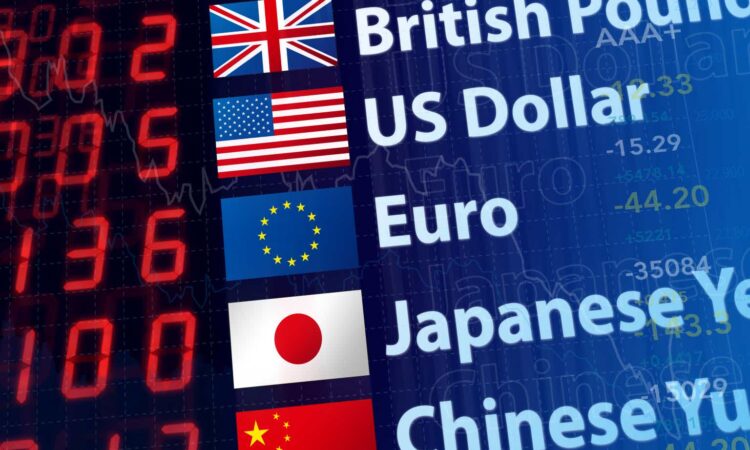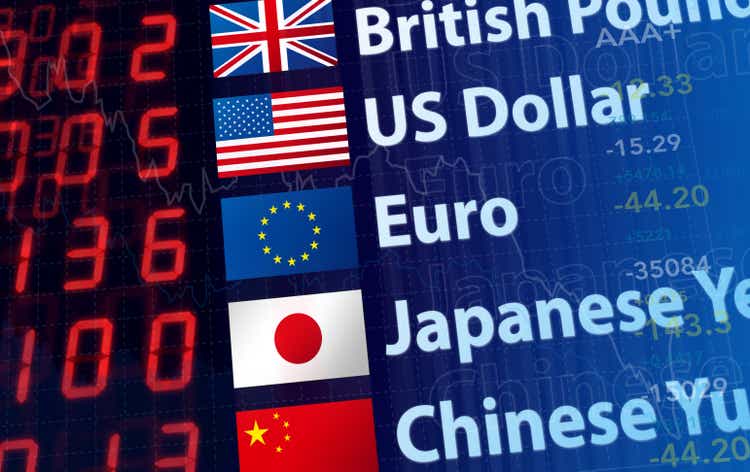
narvikk
Overview
Corrective forces are helping lift the dollar against all the G10 currencies. The euro’s 0.5% pullback is the largest in nearly two months. Sterling’s 0.3% loss is the most in nearly three weeks. The dollar-bloc currencies are the most resilient and are off less than 0.2% today. Emerging market currencies are more mixed. Central European currencies have been dragged lower by the euro. The Chinese yuan is a little softer, consistent with the yen’s pullback. The Mexican peso, which lead the way lower yesterday, is on the top of the EM leaderboard today.
Equities are mostly firmer today. China (SHCOMP) and Hong Kong (HSI) were exceptions among the large bourses in Asia Pacific. Europe’s Stoxx 600 (STOXX) is up nearly 0.5% and US index futures are slightly higher. European 10-year yields are 2-4 bps lower today, unwinding some of yesterday’s rise. The 10-year US Treasury yield (US10Y) is off almost a basis point, slightly below 3.82%. Gold approached the record high set last week ($2532) but, perhaps encouraged by a stronger dollar, profit-taking pushed the yellow metal back to almost $2500. Geopolitics and the disruption of Libyan and Colombian supply helped lift October WTI to about $77.60 on Monday. It consolidated yesterday, falling to about $75.40 and is now near $74.30. A break of the $73.80 area could target the recent low (~$71.50).
Asia Pacific
Australia’s July CPI moderated to 3.5% from 3.8% in June and 4.0% in May. It was slightly more than the median projection in Bloomberg’s survey and remains above the cyclical low seen in December 2023 through February 2024 (3.4%). However, the core trimmed mean fell to 3.8% (from 4.1%) matching the cyclical low set in January. Still, the central bank may not abandon its hawkish rhetoric until the Q3 CPI is reported in late October, ahead of the November 5 policy meeting. Pricing in the swaps market is consistent with about a 50% chance of a rate cut in the next three months, while the futures market has a cut 90% discounted at the last meeting of the year on December 10. Tomorrow is another light regional economic calendar. The highlight is Japan’s weekly portfolio flows. So far, the threat of further BOJ tightening, and the appreciation of the yen, has seen Japanese investors step up their buying of foreign bonds and stocks. Over the past four weeks, Japanese investors bought JPY3.38 trillion of foreign bonds (~$22.8 bln), which is the most for a four-week period since September 2023. They also purchased about JPY1.16 trillion of foreign stocks, the most since January 2023.
Despite the firm 10-year yield, the dollar could not recapture the momentum that had carried it to almost JPY145.20 late in Asia yesterday. As noted yesterday, there are about $3.5 bln in options that expire today at JPY145.25 (~40%) and JPY145.50 (~60%). The dollar slipped below JPY144 in late dealings and settled on its lows. Immediately it was taken out in early Asia Pacific dealings. The dollar found bids near JPY143.70, ahead of Monday’s low (~JPY143.45), and recovered to the JPY144.60 area in early European turnover. The Australian dollar pushed to a new seven-month high after the CPI to about $0.6815. The high for the year was set, according to Bloomberg, near $0.6840 on January 2. Still, with the daily momentum indicators stretched, and corrective pressures evident, the Aussies gains were not sustained. It is trading mostly between $0.6780 and $0.6800 now. The dollar traded higher against the Chinese yuan yesterday and reached CNH7.1340. But, as the dollar surrendered its gains against the yen, it frayed CNH7.12. The softer yen today has seen the yuan slip to a three-day low, with the dollar rising to CNH7.1375. The PBOC set the dollar’s reference rate at CNY7.1216 (CNY7.1249 on Tuesday).
Europe
Money supply M3 growth was unchanged at 2.3% year-over-year in July after the June’s growth was revised from 2.2%. It had been recovering but stalled in July. Recall that from July 2023 through November 2023, M3 was contracting on a year-over-year basis. The 2.3% rise is the strongest since January 2023, when it stood at 3.0%. The credit growth and money supply figures have little immediate impact on the policy outlook, and the swaps market continues to price in at least two more cuts this year. Tomorrow, the monthly series of surveys by the EC will be published, but they are not market movers. The week’s highlight is the preliminary August CPI. A 0.2% month-over-month increase would translate into a 1.6% annualized rate over three months. Given the 0.5% rise last August, which drops out of the 12-month comparison, could see the year-over-year rate ease to 2.2%-2.3% from 2.6% in July.
The euro was confined to a little more than a third of a cent yesterday, its narrowest range in a couple of weeks. It found support near $1.1150, where options for nearly 1.35 bln euros rolled off yesterday. That support has given way today, and the euro is trading near $1.1125 late in the European morning. It is off about 0.5%, which if sustained, would be the largest loss since mid-June. The next area of chart support is around $1.11. Sterling pulled back nearly a half-of-a-cent after setting a new two-year high (~$1.3245) in early European turnover yesterday, and reinforced the importance of the $1.3180-$1.3200 support area. Sterling reached a new high in late North American dealings (~$1.3265). It stalled and has pulled back toward $1.3215 today. Yet, sterling’s momentum indicators are also stretched, suggesting little juice remaining after the six-cent rally since the August 8 low near $1.2665 (the low since July 2).
America
Today’s US calendar is exceptionally light. Outside of the weekly mortgage applications estimate by the MBA, there is no data. The Fed’s Waller speaks on India’s payment system from Mumbai around 1:15 pm ET, and Bostic shares his economic outlook well after the North American markets close (6 pm ET). Tomorrow features another look at Q2 GDP, weekly jobless claims, and July goods trade and (wholesale and retail) inventories. We suspect that the rise in imports is driven by stocking up ahead of the holiday season, given the threat of supply disruptions on several fronts, including a potential dockworkers strike in the US. Mexico’s central bank’s inflation report will be published later today. The swaps market has one quarter-point cut fully discounted over the next three months, and 175 bps of rate reductions over the next 12 months.
The greenback extended its recent losses against the Canadian dollar and saw set a five-month low in late turnover near CAD1.3440. This area is held, and the US dollar recovered toward CAD1.3470. The CAD1.3480-CAD1.3500 area offers initial resistance. Progress on the controversial judicial reform bill in Mexico, and the general souring of sentiment toward the Mexican peso, offset the smaller-than-expected Mexican trade deficit. The peso tumbled 1.8%. It was the sixth consecutive session of more than 1% net change. There is a strong seasonal pattern for deterioration in Mexico’s July trade balance, but instead, a 12% surge in exports offset the nearly 10% jump in imports. The trade deficit narrowed to $72 mln from almost $1.04 bln in June. The median forecast in Bloomberg’s survey was for a $1.7 bln deficit in July. The dollar pushed through last week’s highs (~MXN19.5340) and overcame resistance around MXN19.60 and reached almost MXN19.78. The greenback reached almost MXN19.80 in the Asia Pacific session before sellers emerged and pushed it back toward previous resistance, now support around MXN19.60. A break of the MXN19.48-MXN19.50 area is needed to suggest a top may be in place.
Editor’s Note: The summary bullets for this article were chosen by Seeking Alpha editors.
